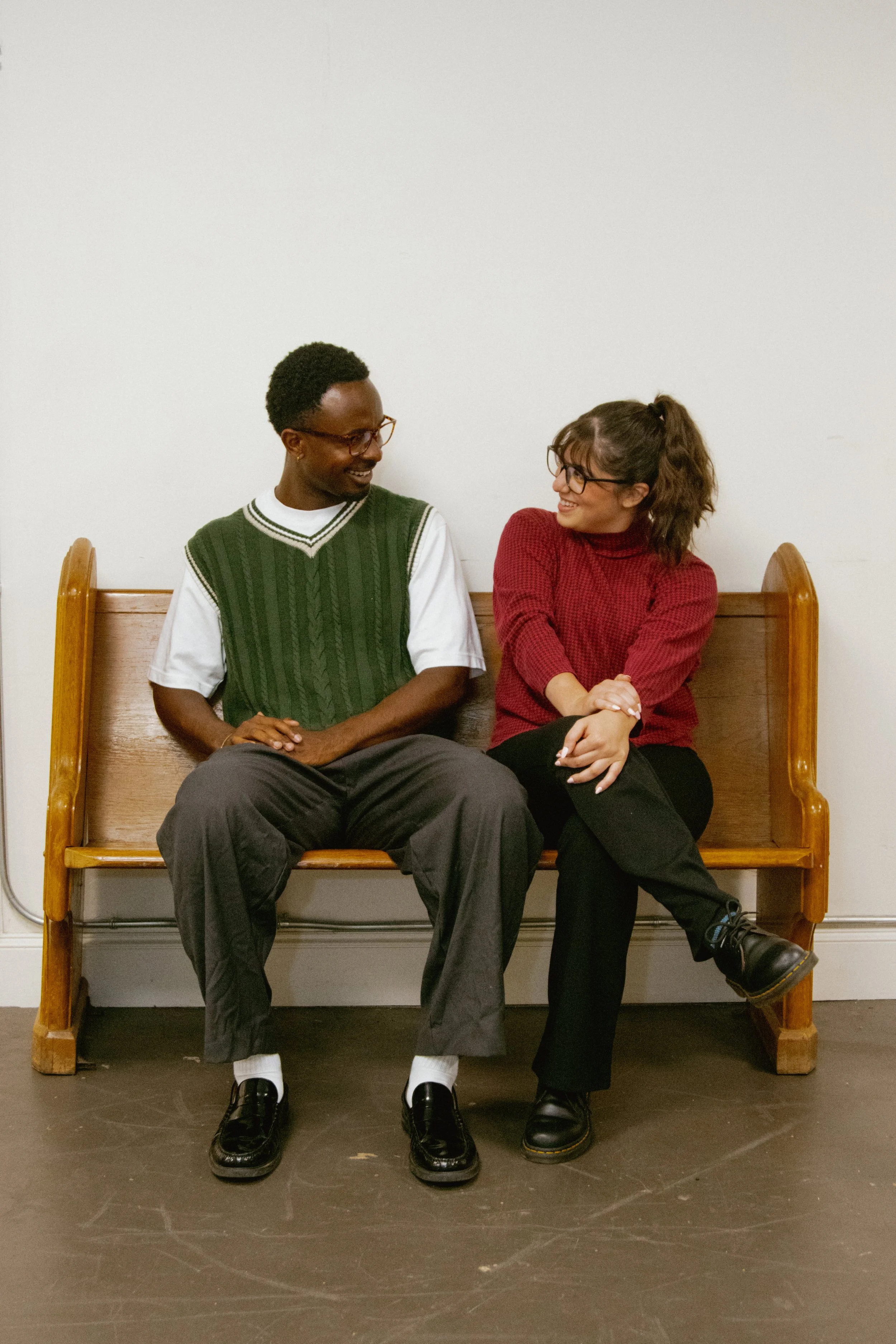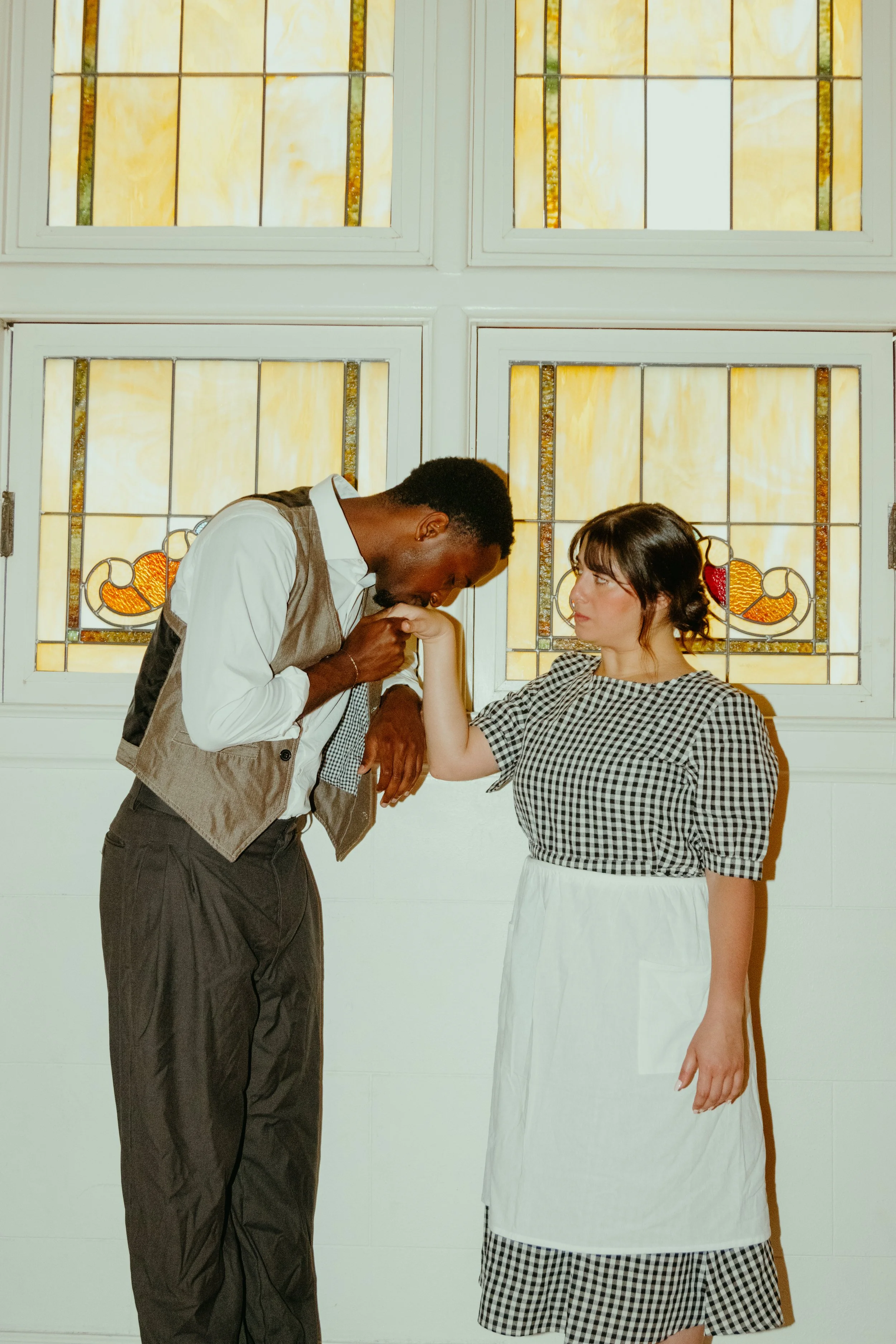Erin Malone Turner’s ‘for the rest of our lives’ @ Arts Mission Oak Cliff
Photos by Dani Holway
—Ryan Maffei
Arts Misson Oak Cliff artist-in-residence Erin Malone Turner is one of the best playwrights most of the country doesn’t know yet. Her talent for depicting messy, textured realism is matched by her flair for higher, more outlandish concepts. As my partner (an even bigger Turner fan) puts it, “she writes things as they are as well as she writes how they could be.”
Yet as Turner humbly indicated during a talkback for closing night of for the rest of our lives—a play marking the culmination of her AMOC residency—she considers many of her plays living, breathing works in progress. This review is a tribute to one of them, an artifact from an experience I hope you get to enjoy too, and soon.
for the rest of our lives is a perfect double-edged title for the play’s premise, which explores both romance and reincarnation with equal amounts of sweetly convinced faith. Savannah Yasmine Elayyach and Caleb Mosley portray a pair of fatefully entwined souls who take three incarnations—and implicitly, many more—to explore vessels who might stand the chance of a happily ever after. Most of us know “happily ever after” as a fairy tale; longtime couples are often in a perpetual fight for if not with each other. Yet however statistically unlikely it is that we’ll find our “soul mates,” the best love feels like just that: not only deeply satisfying but cosmically right, an actual miracle. Turner’s belief in true love is palpable in previous plays, but she’s never given it this much space to breathe.
One could argue that a play about three couples unmistakably meant to be together begs a greater sense of internal conflict. In the first two acts, set in ancient times and the 18th century, the forces working against our central romance are almost entirely external. And in the final act, two irresistible nerds embark on the most unobstructed path to love ever depicted—with any sense of friction not just distant but unlikely. Yet the production sold me on all of the play’s conceits. It helps that it starred two of DFW’s very best actors. And as a director, Turner staged her piece with a shrewd sense of economy, as well as her characteristic talent for welding distinct tones.
The play’s three couples are easy to fall in love with, both as written and as portrayed. First is Petra, a teenage princess chafing at her royal station and cursed with an untimely illness, and Orion, a starstruck yet daring flautist who quickly earns her favor. They reappear as Jude, a well-to-do dairy farmer poisoned with the stuffiness of his age (the 18th century, remember?), and Lily, an ambitious commoner with the hunger and drive to escape it. Then, at an unspecified moment in the near future—far away enough for defunding arts and sciences to have become passé, though let’s cross our fingers—two archaeologists, Amira and (we’ll allow it) Kismet, recover evidence of the prior couples’ bonds of affection. The two scientists have plenty of room for woo-woo; both take little convincing that they share more than just an interest in the bygone pairs of lovers.
While those initial conflicts seem somewhat arbitrary for a duo whose cosmic love the author aims to indulge, the play turns out to be a study in conflict—a love you root for against both earthly and otherworldly barriers. What’s most compelling about the first segments are the symmetry of their contrast. In the first part, the lovers buzz with a joy stolen from systemic oppression, and the power imbalance favors Petra. In the next, the class disparity is narrower, yet the dynamic is flipped, and the patriarchal confines Lily resists are as fearsome as any ancient king’s wrath. In the first, the couple endures, but is no match for death; in the second, the couple fails, and you’re not exactly mad about it. So when everything turns out okay in part three, it functions as a long, sweet exhale.
Anyone who’s watched Elayyach and Mosley perform knows how good they are. Here, they get to do it all, varying techniques while preserving their natural (and well-matched) charms in a believable throughline. Elayyach heightens her approach with Petra, concealing her character’s tragedy in fetching comic business, while as Lily, she totally grounds herself, Masterpiece Theatre as cold hard verité. Conversely, yet in perfect harmony with Elayyach, Mosley’s consistency is his greatest strength. He’s effortlessly endearing through Orion’s naivete and Jude’s pretension; when he lets his emotions loose in just the right amounts, to two different degrees of grief, it’s stirring.
Their easy chemistry survives as the pair pare down this character work for the final couple, and is intensified throughout by Claire Fountain’s stellar intimacy direction. Fountain’s work is always composed of impossibly potent little moments—placements, gestures and calculated hesitations that convey worlds of fluid storytelling and organic emotion, often within just a few seconds. Her efforts here immeasurably elevate two already fantastic performances.
for the rest of our lives’ biggest idea seems to be that love really is powerful enough to level anything in its way. This is best explored in a strange and gorgeous vignette before the final segment. One more spot-on sound cue slowly rises as the lights dim completely (here, sound designer Brian Christensen and lighting designer Lindsey Hertel really shine), and our pair reappears in the simplest black costumes, gazing at each other in softly simmering wonder across the room. Turner liberates her characters from the confines of the stage, letting her actors, and the sum of eons of unrequited emotion, float around the space.
I lost it with that scene, and I trust I wasn’t alone, in a play that had already moved most of us to tears at least once or twice. It’s a dialogue, where words melt indistinguishably into feelings, where two complementary essences need little but to burn for one another. The actors simply exist, and the effect is seismic. I’ll end here with a passage from the scene:
WOMAN: Okay then. Where are we?
MAN: Before and after.
WOMAN: How can this be both before and after?
MAN: It just can. There is space for it to be both.
WOMAN: Hmm. There is space for so much in this world.
WHEN: July 18-19, 2025
WHERE: AMOC, 410 S. Windomere Ave, Dallas
WEB: artsmissionoc.org



